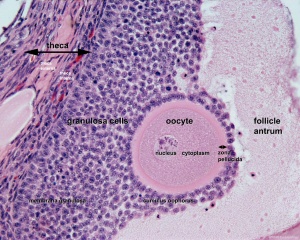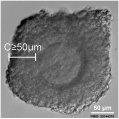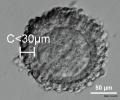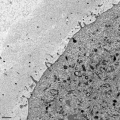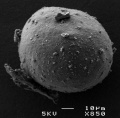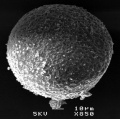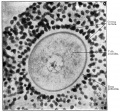Granulosa cell: Difference between revisions
mNo edit summary |
mNo edit summary |
||
| Line 18: | Line 18: | ||
| | | | ||
* ''' | * '''Transcriptomic Diversification of Developing Cumulus and Mural Granulosa Cells in Mouse Ovarian Follicles'''<ref name=PMID25376232><pubmed>25376232</pubmed></ref> "Cumulus cells and mural granulosa cells (MGCs) have functionally distinct roles in antral follicles, and comparison of their transcriptomes at a global and systems level can propel future studies on mechanisms underlying their functional diversity. These cells were isolated from small and large antral follicles before and after stimulation of immature mice with gonadotropins, respectively. Both cell types underwent dramatic transcriptomic changes and differences between them increased with follicular growth. Although cumulus cells of both stages of follicular development are competent to undergo expansion in vitro, they were otherwise remarkably dissimilar with transcriptomic changes quantitatively equivalent to those of MGCs. Gene Ontology analysis revealed that cumulus cells of small follicles were enriched in transcripts generally associated with catalytic components of metabolic processes, while those from large follicles were involved in regulation of metabolism, cell differentiation, and adhesion. Contrast of cumulus cells versus MGCs revealed that cumulus cells were enriched in transcripts associated with metabolism and cell proliferation while MGCs were enriched for transcripts involved in cell signaling and differentiation. In-vitro and in-vivo models were used to test the hypothesis that higher levels of transcripts in cumulus cells versus MGCs is the result of stimulation by oocyte-derived paracrine factors (ODPFs). Surprisingly ~48% of transcripts higher in cumulus cells than MGCs were not stimulated by ODPFs. Those stimulated by ODPFs were mainly associated with cell division, mRNA processing, or the catalytic pathways of metabolism, while those not stimulated by ODPFs were associated with regulatory processes such as signaling, transcription, phosphorylation, or the regulation of metabolism." | ||
|} | |} | ||
Revision as of 23:26, 11 November 2014
| Embryology - 26 Apr 2024 |
|---|
| Google Translate - select your language from the list shown below (this will open a new external page) |
|
العربية | català | 中文 | 中國傳統的 | français | Deutsche | עִברִית | हिंदी | bahasa Indonesia | italiano | 日本語 | 한국어 | မြန်မာ | Pilipino | Polskie | português | ਪੰਜਾਬੀ ਦੇ | Română | русский | Español | Swahili | Svensk | ไทย | Türkçe | اردو | ייִדיש | Tiếng Việt These external translations are automated and may not be accurate. (More? About Translations) |
Introduction
Surrounding the oocyte as it develops within the ovary follicle are multiple layers of granulosa cells that are bound to the thick specialised extracellular matrix, the zona pellucida. Following release of the oocyte at ovulation, these cells form the granolas layer.
Granulosa cells can also have specific names depending upon location within the ovarian follicle: cumulus oophrous (Latin, cumulus = a little mound; Greek, oo= egg, phorus=carrying) granulosa cells directly around the zone pellucida and released with the oocyte; membrana granulosa granulosa cells forming the layer within the follicle antral wall; discus proligerus can refer to the attachment between cumulus oophrous and membrane granulosa.
In human development, during the first week of development following fertilization the granolas cell layer and zona pellucida remains surrounding the blastocyst from which it "hatches" to commence implantation.
Some Recent Findings
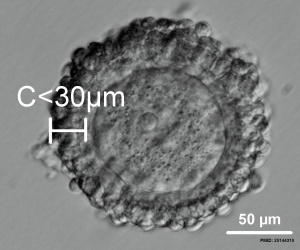
|
| More recent papers |
|---|
|
This table allows an automated computer search of the external PubMed database using the listed "Search term" text link.
More? References | Discussion Page | Journal Searches | 2019 References | 2020 References Search term: Granulosa cell development <pubmed limit=5>Granulosa cell development</pubmed> |
Follicle Granulosa Cells
Granulosa cells can also have specific names depending upon location within the follicle.
|
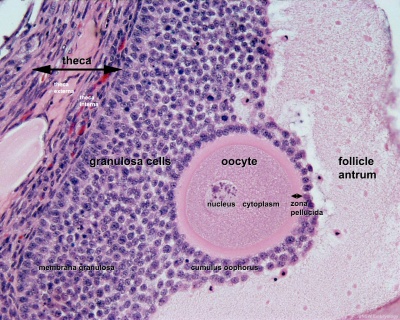
|
Mouse Granulosa Cells
Terms
- acrosome reaction - The chemical change within the spermatozoa following binding to the zona pellucida, that leads to the release of acrosomal enzymatic contents. These enzymes degrade the zona pellucida and allow a spermatozoa to penetrate an oocyte.
- granulosa cell - A specific cell type that proliferates in association with the oocyte within the developing follicles of the ovary. These cells form the follicle stratum granulosa and are also given specific names based upon their position within the follicle. In the antral follicle, membrana granulosa sits on the follicular basal lamina and lines the antrum as a stratified epithelium. The cumulus oophorus is a column of granulosa cells that attaches the oocyte to the follicle wall. The corona radiata are the granulosa cells that directly surround the oocyte, and are released along with it at ovulation. Following ovulation the corona radiata provide physical protection to the oocyte and granulosa cells within the ovulating follicle contribute to corpus luteum.
References
Reviews
<pubmed>18539589</pubmed>
Articles
Bookshelf
Search NCBI Bookshelf zona pellucida | acrosome reaction
Search Pubmed
July 2010 "zona pellucida" All (4801) Review (582) Free Full Text (1408)
Search Pubmed: zona pellucida | acrosome reaction | Zona pellucida protein 1 | Zona pellucida protein 2 | Zona pellucida protein 3 | Zona pellucida protein 4
Search Images: zona pellucida
Additional Images
Mouse oocyte and zona pellucida - light and TEM
Mouse oocyte and zona pellucida TEM
Cat oocyte zona pellucida SEM
Cat oocyte zona pellucida SEM
Cat oocyte zona pellucida spermatozoa bound SEM
Hamster oocyte zona pellucida SEM
Pig ZPC deposition in oocyte-cumulus complexes
External Links
External Links Notice - The dynamic nature of the internet may mean that some of these listed links may no longer function. If the link no longer works search the web with the link text or name. Links to any external commercial sites are provided for information purposes only and should never be considered an endorsement. UNSW Embryology is provided as an educational resource with no clinical information or commercial affiliation.
Glossary Links
- Glossary: A | B | C | D | E | F | G | H | I | J | K | L | M | N | O | P | Q | R | S | T | U | V | W | X | Y | Z | Numbers | Symbols | Term Link
Cite this page: Hill, M.A. (2024, April 26) Embryology Granulosa cell. Retrieved from https://embryology.med.unsw.edu.au/embryology/index.php/Granulosa_cell
- © Dr Mark Hill 2024, UNSW Embryology ISBN: 978 0 7334 2609 4 - UNSW CRICOS Provider Code No. 00098G
